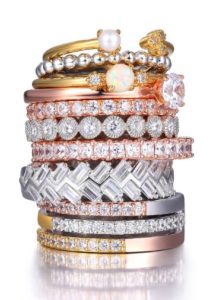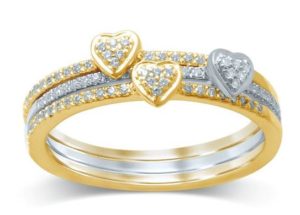Dpa Rolls Out Real Is Rare for Q4
The Diamond Producers Association (DPA) launched its Real is Rare 2017 fourth quarter marketing and ad campaign at JCK Las Vegas during a symposium hosted by The Plumb Club and JCK.
 With a $57 million budget, DPA will fund consumer advertising primarily in the U.S. market, as well as expand the campaign into India and China. Building on its launch last October with two video love stories, DPA is rolling out new video assets for linear and digital TV in Q4.
With a $57 million budget, DPA will fund consumer advertising primarily in the U.S. market, as well as expand the campaign into India and China. Building on its launch last October with two video love stories, DPA is rolling out new video assets for linear and digital TV in Q4.
Now through December, new print ads will run in a dozen lifestyle magazines, including Brides, People, and Marie Claire, and across digital. The ads are available for retailers on DPA’s website, as well as social media, point-of-sale and training material.
Showcasing diamonds as symbols of authentic connections and commitments, DPA’s latest campaign features real couples revealing stolen moments of tenderness where diamond jewelry is the obvious gift of love. The aim is to broaden the emotional territory for diamond moments for purchase, tells Deborah Marquardt, DPA chief marketing officer.
“While our long-term plan will reflect stories around growing areas of the market like self-purchase and family gifting, we started with love and commitment because they represent the biggest retail opportunity,” says Marquardt. “The objective is to link diamonds to the emotion versus the ritual. The couples are in love and committed, but their status is left ambiguous. This approach allows us to speak to committed couples planning to wed and those who are not.”
DPA research cites about 30% of consumers, aged 17-37 is married, 40% fewer than Boomers at the same age. One in five say they don’t intend to wed at all, and those who do are marrying later—29 for men, 27 for women.
Value Diamonds
Marquardt says the data and consumer behavior suggest millennials value diamonds. DeBeers 2016 Diamond Insight Report reveals the millennial share of diamond jewelry sales in the U.S. at 41%, is greater than their share of the population at 27%.
Neil Shah of Shah Luxury, New York City thinks DPA is making progress toward getting the right messaging. “We beat ourselves up as an industry that people aren’t buying diamonds, but they are. They’re just buying them in different ways.”
Shah says his company invested in technology to create products and tools to help retailers be successful, from turnkey branded programs and customization services to exploring augmented reality. “We’re researching what we can do to drive traffic. While millennials research products online, they still enjoy the in-store experience. Retail is good for retailers creating experiences.”
In profiling millennials, the challenge is there’s no single identity for this generation, the most diverse and highly educated in an historic radical era of technological transformation. Marquardt says the industry needs to crack the code on how to best tell millennials the diamond story.
Cracking the Code
Distracted, this generation is never without their cell phones, checking them 150 times a day. Some 80% say that brands wanting their attention better be entertaining or be ignored.
 If Facebook and Instagram have proven anything it’s that the engagement ring photo is king. “It’s the sharing of these life moments on social media that legitimizes them. Once published, this visual story is liked, shared, commented on, and assumed a life of its own,” explains Marquardt, who credits millennials with making diamonds social media stars.
If Facebook and Instagram have proven anything it’s that the engagement ring photo is king. “It’s the sharing of these life moments on social media that legitimizes them. Once published, this visual story is liked, shared, commented on, and assumed a life of its own,” explains Marquardt, who credits millennials with making diamonds social media stars.
Research shows that diamond content on social media works best when including love sentiments; facts, history, lore; quotes, especially about diamonds (boost engagement 38%); celebrities (perform 60% above average); food (cupcakes, cookies or ice cream triple the likes); and pets (double the metrics).
Instagram is where diamond visuals shine brightest. Marquardt cites activity around hashtags like #engaged, #engagementring, #heputaringonit, #shesaidyes—millions of posts in every permutation of engagement, proposal, and ring. The net effect is a narrative where diamond engagement rings play a starring role on social media. Overall, diamond jewelry drives traffic, comments and shares with hashtags from red carpet to milestone to bling.
Millennials set a high bar for marketers because they’re not passive and receptive, rather mobile, multiplatform storytellers and creators. “Connecting with this generation means speaking in stories and writing in pictures,” says Maquardt. “Show stories they can see themselves in, adapt and re-tell.”
Michael Lerche, president/COO of Goldstar Jewellery, New York City says he loves the idea of Real is Rare, and encourages the industry to support it. “We have a lot of catching up to do in communicating a cultural imperative for diamonds and jewelry, with a lost decade since De Beers stopped its national ad campaigns.”
With today’s consumers averaging 20 hours a week on social media, we have to have conversations where customers are, says Kathy Schroeder, director of sales for Prime Art & Jewel, Dallas. Next to stepping up social engagement, she advocates connecting with local influencers and bloggers, showing video and model imagery online and in store, and creating unique messaging in packaging.
Real is Rare will raise awareness and help drive diamond sales in Q4 if jewelry brands and retailers get behind it, believes Andrea Maine co-founder and director of Chrysalis, the London-based Richline brand of expandable charm bangles. The winning formula = visual impact + distinct voice + emotional honesty!







